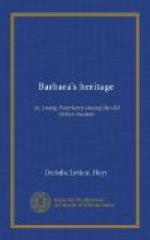“Cimabue thought to
lord it over painting’s field:
But now the cry is Giotto,
and his name’s eclipsed.”
“Yes, indeed! Giotto did eclipse his master’s fame, for he went so much farther,—but only in the same path, however; so we must not take from Cimabue any of the honor that is due him. But for Giotto the old Byzantine method of painting on all gold backgrounds was abolished. This boy, though born of peasants, was not only gifted with keen powers of observation of nature and mankind and a devotion to the representation of things truly as they are, but, beyond and above all this, with one other quality that made his work of incalculable worth to the people among whom he painted. This was a delicate appreciation of the true relations between earthly and spiritual things.
“Before him, as we have seen, all art was most unnatural and monastic,—utterly destitute of sympathy with the feelings of the common people. Giotto changed all this. He made the Christ-child a loving baby; the Madonna a loving mother into whose joy and suffering all mothers’ hearts could enter; angels were servants of men; miracles were wrought by God because He loved and desired to help men; the pictured men and women were like themselves because they smiled and grieved and acted even as they did. All this change Giotto made in the spirit of pictures; and in the ways of painting he also wrought a complete revolution. ‘There are no such things as gold backgrounds in nature,’ he said; ’I will have my people out of doors or in their homes.’ And so he painted the blue sky and rocks and trees and grass, and dressed his men and women in pure, fresh colors, and represented them as if engaged in home duties in the house or in the field. He introduced many characters into his story pictures,—angel visitants, neighbors, wandering shepherds, and even domestic animals. He brought the art of painting down into the minds and hearts of all who looked upon them.”
“I never have realized until lately,” said Barbara, “how painting can be made a source of education and pleasure to everybody. It is so different here from what it is at home, especially because the churches are full of pictures. There we go into the art museums or the galleries of different art-clubs,—the only places where pictures are to be found,—and meet only those people that can afford luxuries; and so the art itself seems a luxury. But here I have seen such poor, sad-looking people, who seem to forget all their miseries in looking at some beautiful sacred picture. Only the other day I overheard a poor woman, whose clothes were wretched and who had one child in her arms and another beside her, trying to explain a picture to them, and she lingered and lingered before it, and then turned away with a pleased, restful face.”




